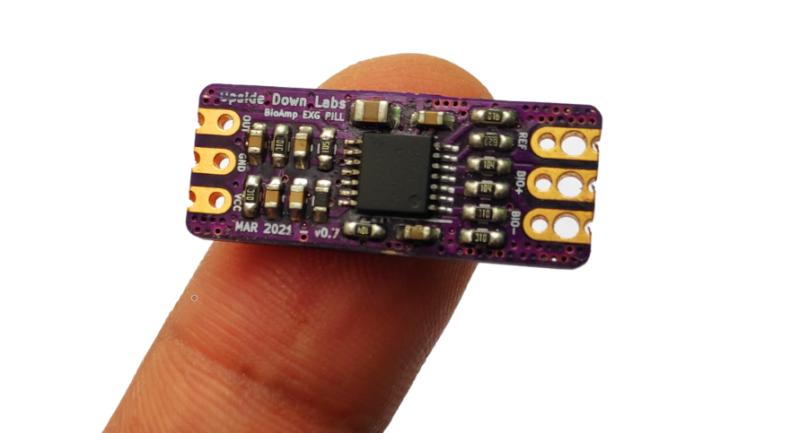The electrical signals emitted by the human body tell us a lot about what’s going on inside. But getting those signals inside your microcontroller is not straightforward: the voltages are too small for most ADCs, and the ever-present 50 or 60 Hz mains frequency makes it hard to discern subtle changes. Over at Upside Down Labs, [Deepak Kathri] developed a universal biosensor interface called the BioAmp EXG Pill to make all this a lot easier.
Its name refers to the fact that it can be used for several different bio-electrical sensing applications: ECG, EMG, EOG and EEG, which deal with signals coming from the heart, muscles, eyes and brain, respectively. To enable such flexibility, the board has connectors for two or three electrodes, as well as solder pads to mount resistors and capacitors to adjust the gain and bandwidth. An instrumentation amplifier increases the strength of the desired signal while rejecting noise and interference.
The form factor allows easy connection to electrodes on one side and a data acquisition system on the other. Measuring just 25.4 mm long and 10 mm wide, it should be easy to integrate into any type of biosensing gizmo you can come up with. [Deepak] has made several demo setups, showing him using the Pill with an Arduino to measure his heart rate, detect eye blinks, and even control a robot arm using his own arm muscles!
The EXG Pill is an evolution of an earlier EMG-only project. We’ve seen several great ECG and EEG projects before, but is the first time we’ve seen one amplifier that can do them all.

















This looks like a nice product, but I would add something to the circuitry – an isolated amp/power supply chip such as the AMC3330DWE, to break any possible shock hazards, so that when you hook it up to yourself / someone else, you reduce the chance of accidental shock / electrocution. [When you hook up circuits to people, always do an appropriate sacrifice [circuit-wise] to Murphy].
It would have be a nice product in the 90s, but today the primitive and noisy opamp, the lack of digital output and the lack of isolation to the body makes me cringe. But yeah 30 years ago, it could have been a product
I agree about both the power supply and the output isolation. Make it run on a couple of button cells and have a serial output that goes into an optical fiber and you have those issues resolved.
The problem with using light to isolate a low-power device is that the current to drive the light source will modulate the power a bit, possibly introducing noise on the power line to the IA.
If you can arrange to transmit when not sampling you can eliminate this at the cost of speed lost while waiting for the sample to be digitized.
I’m sorry but I must refer you to O’Toole’s Commentary On Murphy’s Law: “Murphy was an optimist”.
I lick 3v3 daily, still alive.
It’d be nice to see an active driven guard to minimize offset when used for EEG – the signal source is very hi impedance.
(at least my brain is hi impedance :^)
It would also be very nice to iterate on a four layer board and put all the signals on the inner layers, for more noise margin.
But that would most likely require another half cm in length to accommodate the vias for the top-layer components.
But that’s a great stitching job here around the edges where it’s usually an afterthought.
TI has been making EKG, EMG, and EEG sensors for years I guess it nice that someone has made a sketch. I used one when I say the ears that move in that toy years ago.
Finally the missing link, can’t wait to buy it from china!
You can back the project on Crowd Supply, https://www.crowdsupply.com/upside-down-labs/bioamp-exg-pill
Sounds like the cheapest brain interface, look out Elon!
Is the notch filter set at 50Hz or 60Hz ?
It has very good interference rejection, it’s capable of rejecting both 50Hz and 60Hz very well.
See the demo videos on the Crowd Supply, https://www.crowdsupply.com/upside-down-labs/bioamp-exg-pill
Seriously? A TL074 set up as a crappy differential amplifier in a “not instrumentation amplifier” setup? For a few extra bucks get a good AD instrumentation amplifier. Also it is imperative to either use with electrical insulation or use it battery operated (maybe it can send the signal to the computer via BT or WiFi. Pretty but really a quite not so good design, I am sorry to say.
Yes, I agree. I wonder if it was availability. Actual purpose-built monolythic IAs have excellent CMRR. And TL074 isn’t even rail-to-rail input, is it? That’s gonna limit common mode voltage range.
Let’s use this as inspiration and come up with a slightly pricier but higher performance unit. Perhaps with an active guard for the leads.,
We are doing a crowd supply campaign for the BioAmp EXG Pill, if you like the project please consider supporting us at https://www.crowdsupply.com/upside-down-labs/bioamp-exg-pill